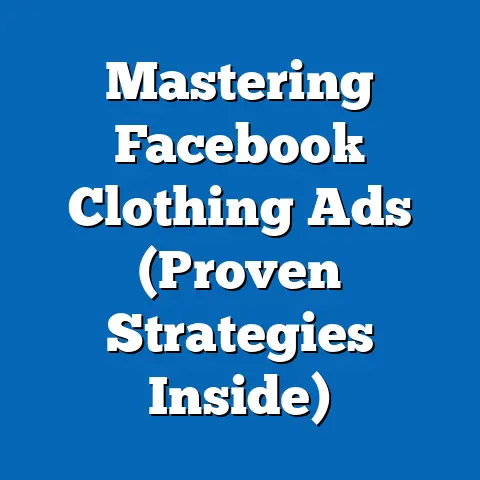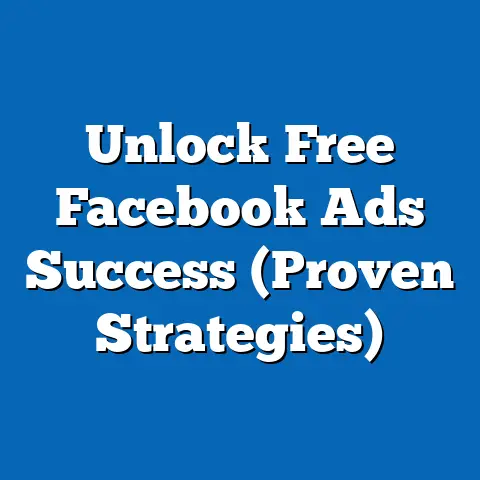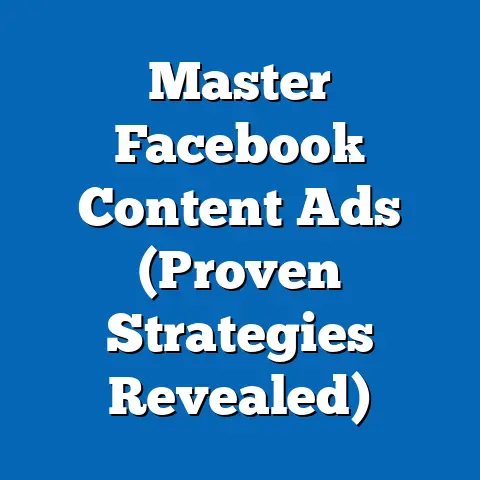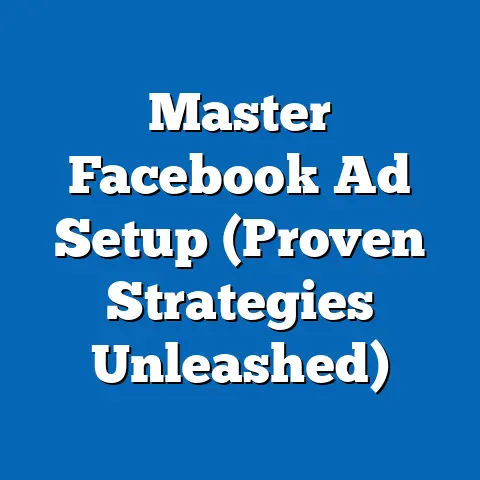Revamp Facebook Ad Targeting (Expert Strategies Inside)
Facebook advertising. It’s a landscape that’s both incredibly powerful and perpetually shifting. I’ve spent years navigating its intricacies, witnessing firsthand the rise and fall of countless strategies. What I’ve learned is this: the “best option” in Facebook ad targeting isn’t a static setting, but a dynamic approach. While many advertisers stick to the familiar comfort of basic demographics and interests, the real magic happens when you dive into the advanced targeting strategies. This is where you unlock the true potential of Facebook advertising and maximize your ROI.
The world of digital advertising is constantly evolving. Algorithms change, user behavior shifts, and what worked yesterday might not work today. To truly succeed, you need to move beyond the basics and understand the nuances of Facebook’s targeting capabilities. This article isn’t just another guide; it’s a deep dive into expert strategies I’ve personally used and refined over the years. These strategies are designed to help businesses like yours not just reach more people, but reach the right people, ultimately achieving your advertising goals with laser-like precision. Consider this your roadmap to transforming your Facebook ad targeting from good to exceptional. Let’s get started.
Understanding Facebook’s Targeting Options
Before we get into the nitty-gritty of advanced strategies, let’s lay the foundation by understanding the core targeting options available on Facebook. Think of these as the building blocks upon which you’ll construct your sophisticated campaigns.
-
Demographic Targeting: This is the most basic, yet still crucial, form of targeting. You can reach users based on age, gender, education, location, relationship status, and job title. It’s a great starting point for defining your target audience, but shouldn’t be your only focus.
-
Interest-Based Targeting: This allows you to target users based on their interests, hobbies, and pages they’ve liked. Facebook gathers this data from user activity on the platform, providing a wealth of information to tap into. Are you selling hiking gear? Target people interested in “hiking,” “outdoor adventure,” and specific hiking brands.
-
Behavioral Targeting: This goes a step further, targeting users based on their online behavior, purchase history, device usage, and other activities. For example, you can target people who frequently travel, use online banking, or have recently purchased a home.
Demographic Targeting: This is the most basic, yet still crucial, form of targeting. You can reach users based on age, gender, education, location, relationship status, and job title. It’s a great starting point for defining your target audience, but shouldn’t be your only focus.
Interest-Based Targeting: This allows you to target users based on their interests, hobbies, and pages they’ve liked. Facebook gathers this data from user activity on the platform, providing a wealth of information to tap into. Are you selling hiking gear? Target people interested in “hiking,” “outdoor adventure,” and specific hiking brands.
Behavioral Targeting: This goes a step further, targeting users based on their online behavior, purchase history, device usage, and other activities. For example, you can target people who frequently travel, use online banking, or have recently purchased a home.
The real power of Facebook targeting comes alive with Custom Audiences and Lookalike Audiences. These are game-changers, and I’ve seen them dramatically improve campaign performance time and time again.
-
Custom Audiences: These allow you to upload your existing customer data (email lists, phone numbers) or target people who have interacted with your website or Facebook page. Imagine targeting people who abandoned their shopping carts on your website – that’s a Custom Audience in action.
-
Lookalike Audiences: This is where the magic truly happens. You can take your Custom Audience (e.g., your best customers) and ask Facebook to find users who are similar to them. Facebook’s algorithm analyzes the characteristics of your Custom Audience and identifies users who share those same traits. This is an incredibly effective way to expand your reach and find new customers who are likely to convert.
Custom Audiences: These allow you to upload your existing customer data (email lists, phone numbers) or target people who have interacted with your website or Facebook page. Imagine targeting people who abandoned their shopping carts on your website – that’s a Custom Audience in action.
Lookalike Audiences: This is where the magic truly happens. You can take your Custom Audience (e.g., your best customers) and ask Facebook to find users who are similar to them. Facebook’s algorithm analyzes the characteristics of your Custom Audience and identifies users who share those same traits. This is an incredibly effective way to expand your reach and find new customers who are likely to convert.
Finally, let’s not forget the Facebook Pixel. This small piece of code placed on your website is like a silent observer, tracking user behavior and providing invaluable data for your advertising campaigns. The Pixel allows you to:
- Track Conversions: See which ads are driving sales and other desired actions.
- Retarget Website Visitors: Show ads to people who have visited your website.
- Create Lookalike Audiences: As mentioned above, the Pixel helps you build Lookalike Audiences based on your website visitors.
The evolution of Facebook’s ad targeting capabilities is constant. What was considered cutting-edge a year ago might now be standard practice. I make it a point to stay abreast of the latest updates and algorithm changes, and you should too. Regularly checking Facebook’s Business Help Center and following industry blogs are great ways to stay informed.
Takeaway: Mastering the fundamental targeting options is crucial for Facebook ad success. Leverage Custom and Lookalike Audiences, and always have the Facebook Pixel installed on your website.
Advanced Targeting Strategies
Now that we’ve covered the basics, let’s dive into the advanced strategies that will truly set your Facebook ad campaigns apart. These are the techniques I rely on to achieve exceptional results for my clients.
Niche Targeting
In my experience, one of the biggest mistakes advertisers make is trying to appeal to everyone. The more specific you can be with your targeting, the better your results will be. Niche targeting involves identifying and targeting very specific, narrowly defined audience segments.
For example, instead of targeting “fitness enthusiasts,” you could target “yoga enthusiasts who are interested in sustainable living.” The more specific you are, the more relevant your ads will be, leading to higher engagement and conversion rates.
I once worked with a small business that sold handcrafted leather journals. Instead of targeting “writers,” we targeted “writers who are interested in fountain pens and vintage paper.” This niche targeting resulted in a 300% increase in conversion rates. Why? Because the ads felt incredibly relevant and personal to the target audience.
Here’s how to implement niche targeting:
- Identify Your Ideal Customer: Create a detailed customer persona that includes their demographics, interests, behaviors, and pain points.
- Research Niche Interests: Use Facebook’s Audience Insights tool to discover niche interests related to your product or service.
- Test Different Audience Segments: Create multiple ad sets, each targeting a different niche audience. Track your results carefully to see which segments perform best.
Layering Targeting Options
Layering targeting options takes your audience definition to the next level. It involves combining different targeting options (e.g., interests and demographics) to create highly specific audience segments.
For example, you could target “women aged 25-35 who are interested in fashion and live in New York City.” By layering these targeting options, you’re reaching a very specific audience segment that is more likely to be interested in your product or service.
I’ve found that layering works particularly well when you’re targeting a very competitive market. By narrowing your audience, you can reduce ad costs and improve your ROI.
Here’s how to layer targeting options:
- Start with a Broad Audience: Begin with a broad audience segment based on demographics or interests.
- Add Layers of Specificity: Add additional layers of targeting based on behaviors, interests, or custom audiences.
- Monitor Audience Size: Be careful not to narrow your audience too much. Aim for an audience size of at least 100,000 people.
Dynamic Ads for Retargeting
Dynamic ads are a powerful retargeting tool that allows you to show personalized ads to people who have shown interest in your product but did not convert. These ads automatically display the specific products that users have viewed on your website, reminding them of what they left behind.
I’ve seen dynamic ads consistently outperform standard retargeting ads. They feel more relevant and personalized, leading to higher click-through rates and conversion rates.
Here are some best practices for creating compelling retargeting ads:
- Use High-Quality Images: Showcase your products with clear, attractive images.
- Write Compelling Copy: Highlight the benefits of your product and create a sense of urgency.
- Offer a Discount or Promotion: Incentivize users to complete their purchase with a special offer.
- Use a Clear Call-to-Action: Tell users exactly what you want them to do (e.g., “Shop Now,” “Add to Cart”).
Utilizing Insights and Analytics
Data is your best friend when it comes to Facebook advertising. Facebook Insights and Analytics provide a wealth of information about your audience, your ad performance, and your overall campaign effectiveness.
By leveraging this data, you can refine your targeting strategies over time and make informed decisions about your ad spend. I always tell my clients: “Don’t just set it and forget it. Continuously analyze your data and optimize your campaigns.”
Here are some key metrics to track:
- Reach: The number of people who saw your ad.
- Impressions: The number of times your ad was displayed.
- Click-Through Rate (CTR): The percentage of people who clicked on your ad.
- Conversion Rate: The percentage of people who completed a desired action (e.g., purchase, sign-up).
- Cost Per Acquisition (CPA): The cost of acquiring a new customer.
By monitoring these metrics, you can identify areas for improvement and optimize your campaigns for maximum ROI.
Takeaway: Advanced targeting strategies like niche targeting, layering, dynamic ads, and data analysis are essential for maximizing your Facebook ad performance.
Creative Approaches to Targeting
Beyond the technical aspects of targeting, there’s also a creative element. How can you think outside the box to reach your target audience in a more engaging and effective way? Here are a few creative approaches I’ve found particularly useful.
A/B Testing Different Audiences
A/B testing is a fundamental principle of digital marketing, and it applies just as much to your audience targeting as it does to your ad creative. By A/B testing different audience segments, you can identify the most responsive targets and optimize your ad spend accordingly.
I recommend testing at least two different audience segments for each ad campaign. You can test different interests, demographics, or custom audiences. Track your results carefully to see which segments perform best.
For example, if you’re selling a product that appeals to both men and women, you could create two ad sets: one targeting men and one targeting women. By comparing the performance of these two ad sets, you can see which gender is more responsive to your ads.
Engagement Custom Audiences
Engagement Custom Audiences are a powerful way to retarget users who have already shown interest in your brand. You can create Custom Audiences based on engagement with your previous ads, posts, or videos.
For example, you could create a Custom Audience of people who have watched at least 50% of your video ad. These users are clearly interested in your product or service, and they’re more likely to convert if you retarget them with a special offer.
I’ve found that Engagement Custom Audiences are particularly effective for building brand awareness and driving sales.
Seasonal and Event-Based Targeting
Leveraging seasonal trends and events can be a great way to refine your targeting and reach users at the right time with relevant messages.
For example, if you’re selling holiday gifts, you could target users who are interested in “Christmas” or “Hanukkah” during the holiday season. Or, if you’re selling back-to-school supplies, you could target parents of school-aged children in the weeks leading up to the start of the school year.
I’ve seen seasonal and event-based targeting dramatically increase ad performance during key periods. It’s all about timing and relevance.
Takeaway: Don’t be afraid to get creative with your targeting. A/B test different audiences, leverage Engagement Custom Audiences, and take advantage of seasonal and event-based targeting.
Future Trends in Facebook Ad Targeting
The world of Facebook advertising is constantly evolving, and it’s important to stay ahead of the curve. Here are a few emerging trends in Facebook ad targeting that I’m keeping a close eye on.
- AI and Machine Learning: Facebook is increasingly using AI and machine learning to improve ad targeting. These technologies can analyze vast amounts of data to identify patterns and predict which users are most likely to convert.
- Privacy Regulations: Privacy regulations like GDPR and CCPA are having a significant impact on ad targeting. Advertisers need to be more transparent about how they’re collecting and using user data.
- Augmented Reality (AR) Ads: AR ads allow users to interact with your product in a virtual environment. This is a highly engaging and immersive ad format that is likely to become more popular in the future.
The key to success in Facebook advertising is to stay adaptable and continuously learn as the platform evolves. Don’t be afraid to experiment with new targeting options and ad formats.
Takeaway: Stay informed about emerging trends in Facebook ad targeting and be prepared to adapt your strategies accordingly.
Conclusion
Revamping your Facebook ad targeting strategies is essential for achieving optimal results. By implementing the expert strategies discussed in this article, you can reach the right people with the right message at the right time.
Remember that successful Facebook advertising requires a blend of creativity, data analysis, and a willingness to adapt to new trends. Continuously experiment with your targeting and track your results carefully. With the right approach, you can unlock the full potential of Facebook advertising and achieve your business goals.
I’ve shared my personal experiences and insights throughout this guide, and I hope they’ve provided you with valuable knowledge and actionable strategies. Now, it’s your turn to put these principles into practice and transform your Facebook ad campaigns. The world of Facebook advertising is waiting – go out there and conquer it!





